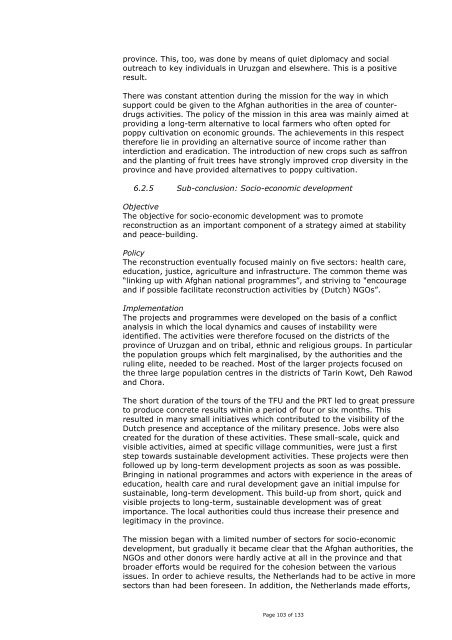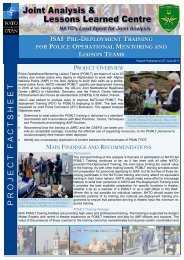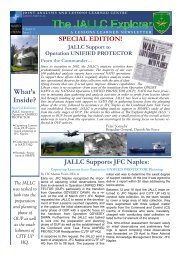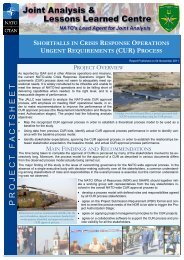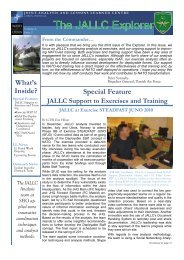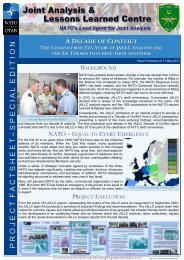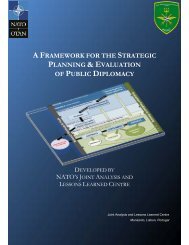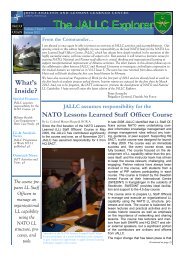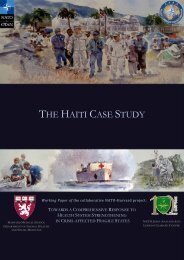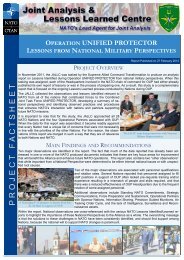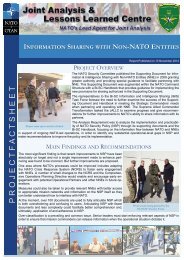Final evaluation Netherlands participation in ISAF 2006 - 2010
Final evaluation Netherlands participation in ISAF 2006 - 2010
Final evaluation Netherlands participation in ISAF 2006 - 2010
You also want an ePaper? Increase the reach of your titles
YUMPU automatically turns print PDFs into web optimized ePapers that Google loves.
prov<strong>in</strong>ce. This, too, was done by means of quiet diplomacy and socialoutreach to key <strong>in</strong>dividuals <strong>in</strong> Uruzgan and elsewhere. This is a positiveresult.There was constant attention dur<strong>in</strong>g the mission for the way <strong>in</strong> whichsupport could be given to the Afghan authorities <strong>in</strong> the area of counterdrugsactivities. The policy of the mission <strong>in</strong> this area was ma<strong>in</strong>ly aimed atprovid<strong>in</strong>g a long-term alternative to local farmers who often opted forpoppy cultivation on economic grounds. The achievements <strong>in</strong> this respecttherefore lie <strong>in</strong> provid<strong>in</strong>g an alternative source of <strong>in</strong>come rather than<strong>in</strong>terdiction and eradication. The <strong>in</strong>troduction of new crops such as saffronand the plant<strong>in</strong>g of fruit trees have strongly improved crop diversity <strong>in</strong> theprov<strong>in</strong>ce and have provided alternatives to poppy cultivation.6.2.5 Sub-conclusion: Socio-economic developmentObjectiveThe objective for socio-economic development was to promotereconstruction as an important component of a strategy aimed at stabilityand peace-build<strong>in</strong>g.PolicyThe reconstruction eventually focused ma<strong>in</strong>ly on five sectors: health care,education, justice, agriculture and <strong>in</strong>frastructure. The common theme was“l<strong>in</strong>k<strong>in</strong>g up with Afghan national programmes”, and striv<strong>in</strong>g to "encourageand if possible facilitate reconstruction activities by (Dutch) NGOs”.ImplementationThe projects and programmes were developed on the basis of a conflictanalysis <strong>in</strong> which the local dynamics and causes of <strong>in</strong>stability wereidentified. The activities were therefore focused on the districts of theprov<strong>in</strong>ce of Uruzgan and on tribal, ethnic and religious groups. In particularthe population groups which felt marg<strong>in</strong>alised, by the authorities and therul<strong>in</strong>g elite, needed to be reached. Most of the larger projects focused onthe three large population centres <strong>in</strong> the districts of Tar<strong>in</strong> Kowt, Deh Rawodand Chora.The short duration of the tours of the TFU and the PRT led to great pressureto produce concrete results with<strong>in</strong> a period of four or six months. Thisresulted <strong>in</strong> many small <strong>in</strong>itiatives which contributed to the visibility of theDutch presence and acceptance of the military presence. Jobs were alsocreated for the duration of these activities. These small-scale, quick andvisible activities, aimed at specific village communities, were just a firststep towards susta<strong>in</strong>able development activities. These projects were thenfollowed up by long-term development projects as soon as was possible.Br<strong>in</strong>g<strong>in</strong>g <strong>in</strong> national programmes and actors with experience <strong>in</strong> the areas ofeducation, health care and rural development gave an <strong>in</strong>itial impulse forsusta<strong>in</strong>able, long-term development. This build-up from short, quick andvisible projects to long-term, susta<strong>in</strong>able development was of greatimportance. The local authorities could thus <strong>in</strong>crease their presence andlegitimacy <strong>in</strong> the prov<strong>in</strong>ce.The mission began with a limited number of sectors for socio-economicdevelopment, but gradually it became clear that the Afghan authorities, theNGOs and other donors were hardly active at all <strong>in</strong> the prov<strong>in</strong>ce and thatbroader efforts would be required for the cohesion between the variousissues. In order to achieve results, the <strong>Netherlands</strong> had to be active <strong>in</strong> moresectors than had been foreseen. In addition, the <strong>Netherlands</strong> made efforts,Page 103 of 133


